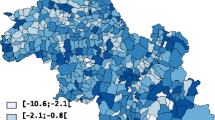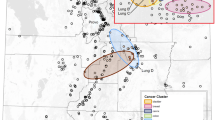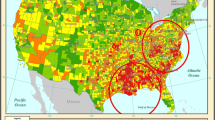Abstract
Elevated cancer rates in some areas may arise simply by chance. The pattern generally warrants a study only when it is statistically significant. This research uses a recently developed spatial statistic, implemented in a Geographic Information System (GIS) environment, to detect spatial clusters of diagnostically specific cancers in Illinois. On the basis of the cancer incidence data (the 1986–1990 and 1996-2000 data sets) from the Illinois Cancer Registry, the study examines different clustering patterns of four leading types of cancer in Illinois, namely breast, lung, colorectal, and prostate cancers. The first part of the study uses the data at the county level, and the second part uses the data in zip code areas. The analysis using the zip code area data directly may be problematic since the rate estimates for rare events like cancer in small populations are susceptible to data errors. The spatial order method is used to group zip code areas so that the new geographic areas have sufficiently large base populations for estimates of reliable cancer rates. Results from the spatial cluster analysis may be valuable for other researchers to design follow-up case-control and retrospective cohort studies.
Similar content being viewed by others
REFERENCES
American Cancer Society, Cancer Facts and Figures 1998, American Cancer Society, Atlanta, 1998.
Ries, L. A. G., Eisner, M. P., Kosary, C. L., Hankey, B. F., Miller, B. A., Clegg, L., Mariotto, A., Fay, M. P., Feuer, E. J., Edwards, B. K. (eds.), SEER Cancer Statistics Review, 1975-2000, National Cancer Institute, Bethesda, MD, 2003. http://seer.cancer.gov/csr/1975_2000 (last accessed October 29, 2003), 2003.
Kulldorff, M., Statistical methods for spatial epidemiology: Tests for randomness. In Gatrell, A. C., and Loytonen, M. (eds.), GIS and Health, Taylor & Francis, London, pp. 49-62, 1998.
Jacquez, G. M., GIS as an enabling technology. In Gatrell, A. C., and Loytonen, M. (eds.), GIS and Health, Taylor & Francis, London, pp. 17-28, 1998.
Walter, S. D., Visual and statistical assessment of spatial clustering in mapped data. Stat. Med. 12:1275-1291, 1993.
Openshaw, S., Charlton, M., Mymer, C., and Craft, A. W., A Mark 1 Geographical Analysis Machine for the automated analysis of point data sets. Int. J. Geog. Inf. Syst. 1:335-358, 1987.
Besag, J., and Newell, J., The detection of clusters in rare diseases. J. R. Stat. Soc. Ser. A 15:4143-4155, 1991.
Rushton, G., and Lolonis, P., Exploratory spatial analysis of birth defect rates in an urban population. Stat. Med. 7:717-726, 1996.
Grimson, R. C., and Rose, R. D., A versatile test for clustering and a proximity analysis of neurons. Methods Inf. Med. 30:299-303, 1991.
Cuzick, J., and Edwards, R., Spatial clustering for inhomogeneous populations. J. R. Stat. Soc. Ser. B 52:73-104, 1990.
Turnbull, B. W., Iwano, E. J., Burnett, W. S., Howe, H. L., and Clark, L. C., Monitoring for clusters of disease: Application to leukemia incidence in Upstate New York. Am. J. Epidemiol. 132:S136-S143, 1990.
Kulldorff, M., and Nagarwalla, N., Spatial disease clusters: Detection and inference. Stat. Med. 14:799-810, 1995.
Oden, N., Jacquez, G., and Grimson, R., Realistic power simulations compare point-and area-based disease cluster tests. Stat. Med. 15:783-806, 1996.
Cliff, A. D., and Ord, J. K., Spatial Autocorrelation, Pion, London, 1973.
Anselin, L., Local Indicators of Spatial Association - LISA. Geog. Anal. 27:93-115, 1995.
Getis, A., and Ord., J. K., The analysis of spatial association by use of distance statistics. Geog. Anal. 24:189-206, 1992.
Oden, N., Adjusting Moran's I for population density. Stat. Med. 14:17-26, 1995.
Rogerson, P. A., The detection of clusters using a spatial version of the chi-square goodness-of-fit statistic. Geog. Anal. 31:130-147, 1999.
Teppo, L., Problems and possiblities in the use of cancer data by GIS―Experience in Finland. In Gatrell, A. C., and Loytonen, M., (eds.), GIS and Health, Taylor & Francis, London, pp. 167-177, 1998.
Haining, R., Spatial statistics and the analysis of health data. In Gatrell, A. C., and Loytonen, M. (eds.), GIS and Health, Taylor & Francis, London, pp. 29-47, 1998.
Krautheim, K. R., and Aldrich, T. E., Geographic Information System (GIS) studies of cancer around NPL sites. Toxicol. Ind. Health 13:357-362, 1997.
White, E., and Aldrich, T. E., Geographic studies of pediatric cancer near hazardous waste sites. Arch. Environ. Health 54:390-398, 1999.
Haining, R., Wises, S., and Blake, M., Constructing regions for small area analysis: Material deprivation and colorectal cancer. J. Public Health Med. 16:429-438, 1994.
Lam, N., and Liu, K., Use of space-filling curves in generating a national rural sampling frame for HIV-AIDS research. Prof. Geog. 48:321-332, 1996.
Black, R. J., Sharp, L., and Urquhart, J. D., Analysing the spatial distribution of disease using a method of constructing geographical areas of approximately equal population size. In Alexander, P. E., and Boyle, P. (eds.), Methods for Investigating Localized Clustering of Disease, International Agency for Research on Cancer, Lyon, France, pp. 28-39, 1996.
Fortheringham, A. S., Brunsdon, C., and Charlton, M., Quantitative Geography: Perspectives on Spatial Data Analysis, Sage, London, 2000.
Bartholdi, J. J.,<suffix>III</suffix>, and Platzman, L. K., Heuristics based on spacefilling curves for combinatorial problems in Euclidean space. Manage. Sci. 34:291-305, 1988.
Author information
Authors and Affiliations
Rights and permissions
About this article
Cite this article
Wang, F. Spatial Clusters of Cancers in Illinois 1986–2000. Journal of Medical Systems 28, 237–256 (2004). https://doi.org/10.1023/B:JOMS.0000032842.78643.38
Issue Date:
DOI: https://doi.org/10.1023/B:JOMS.0000032842.78643.38




